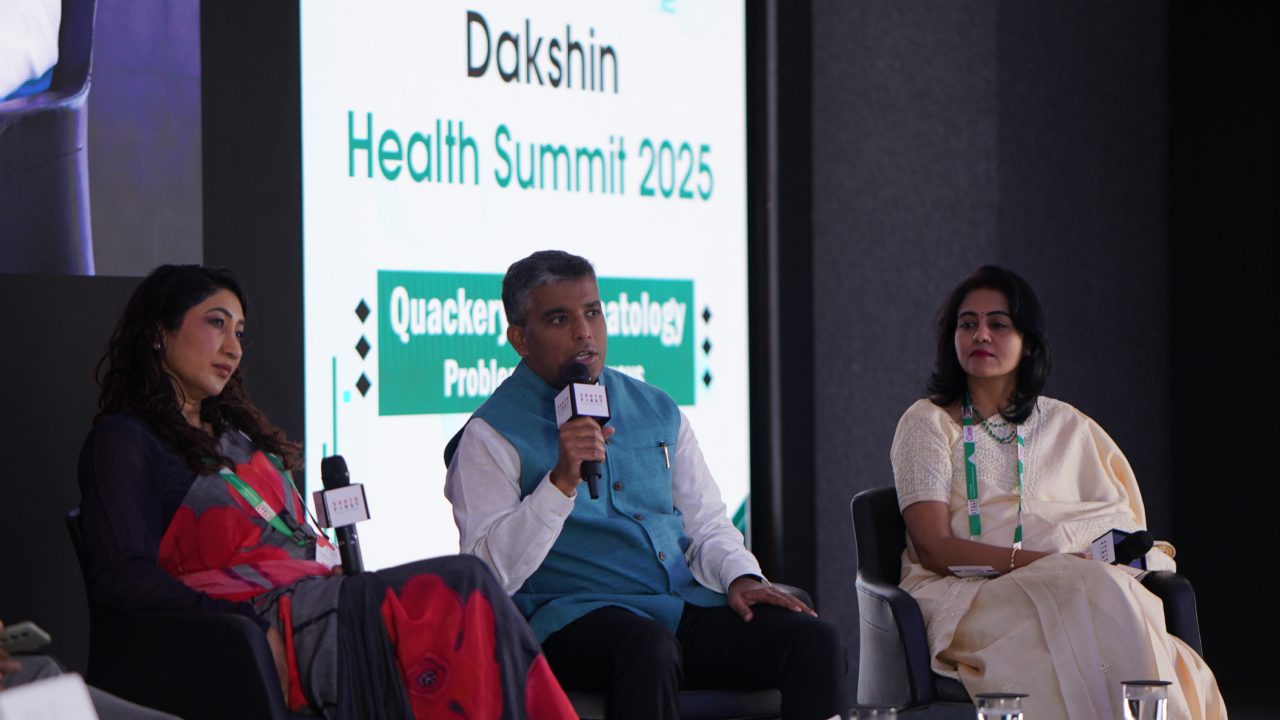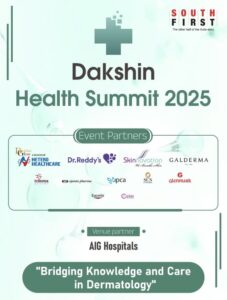Dr Damisetty identified critical issue: Qualified doctors inadvertently enabling quackery through detailed procedural content.
Published Nov 13, 2025 | 7:00 AM ⚊ Updated Nov 13, 2025 | 10:25 AM

Dakshin Health Summit 2025: The panel shared disturbing examples of digital quackery's impact.
Synopsis: India faces 2 million Instagram “skin doctors” against only 18,000 NMC-registered dermatologists. Experts warn of rampant digital quackery—unverified teleconsultations, DIY chemical peels, and 50% glycolic “fairness” oils causing severe burns and scars. Panel demands strict enforcement of telemedicine guidelines and curbs on influencer-driven skincare misinformation.
For every qualified dermatologist registered with India’s National Medical Commission, there are over 100 self-proclaimed “skin doctors” operating on Instagram alone, creating what medical experts are calling a full-blown digital quackery crisis that poses serious risks to public health.
At the second edition of South First’s Dakshin Health Summit, during a panel discussion on ‘Social Media and Skin & Hair Health’ held at the Asian Institute of Gastroenterology (AIG), Gachibowli, on Sunday, leading dermatologists outlined the staggering scale of unqualified practitioners leveraging social media platforms to offer medical advice and treatments.

The second edition of the Dakshin Health Summit 2025 was held at the Asian Institute of Gastroenterology in Hyderabad on Sunday, 9 November.
Dr Jalagam Vijay, dermatologist and co-opted member of the legal and anti-quackery committee at Telangana Medical Council, Hyderabad, provided stark numbers.
“People don’t have access to qualified dermatologists—but they do have access to their phones and to social media. On Instagram alone, you’ll find two million self-proclaimed ‘skin doctors,’ while the NMC lists only around 18,000 actual dermatologists in India.”
Dr Rajetha Damisetty, senior dermatologist, founder–director of Mohana Skin, Hair & Aesthetic Clinic, and Organising Chairperson of Dakshin Health Summit, who also chairs IADVL’s Anti-Quackery, Legal and Ethics Committee, explained the fundamental problem with online medical practice.
“Social media has become a major facilitator of quackery because it gives people enormous reach. One big concern is online consultations. How do you verify credentials online? How do you know whether a clinic even has an establishment license? Where would they display it? In India, we have telemedicine guidelines, and they are very clear—you can barely prescribe anything significant during the first consultation, except for follow-ups.”
She outlined the legal restrictions: “There are certain medications like anti-diabetic or anti-hypertensive drugs that can be continued, and in dermatology, we can continue treatments such as for psoriasis. But we are not allowed to prescribe drugs like methotrexate, acitretin, immunosuppressants, or biologics during initial consultations.”
Dr Damisetty concluded: “So, digital quackery—enabled by these unregulated online consults—is a real threat.”
Beyond credential fraud, Dr Damisetty identified another critical issue: Qualified doctors inadvertently enabling quackery through detailed procedural content.
“Another problem is that when we post too much detailed content online, we unintentionally enable imitation. For example, if I’m creating awareness about an acne-scar procedure or a laser treatment, that’s fine. But if I start showing how to inject Botox, where to inject, how many units, and so on, that turns into a DIY-style video. It creates a dangerous platform where unqualified people start copying these procedures.”
She drew a stark comparison: “If Salman Khan performs a dangerous stunt, there’s at least a disclaimer that it must be done by trained professionals in controlled conditions. But who’s safeguarding the public here? That’s the problem—we are enabling these unsafe practices in the name of awareness.”
Dr Vijay explained the psychology behind the spread of digital quackery.
“For them, it’s much easier to reach these so-called experts online. And because many aren’t highly educated, they’re easily influenced—by the look of the influencer, by the ‘before-and-after’ photos, or by how confidently these people talk. That’s a big reason why misinformation is spreading so fast on social media.”
The panel shared disturbing examples of digital quackery’s impact.
Dr Sandeepthi described a case: “This patient tried a DIY hack she found online—she used soda lime to remove her DPNs (dermatosis papulosa nigra). Unfortunately, it caused severe burns and scarring. It’s a painful reminder that what looks simple or harmless online can sometimes cause permanent damage.”
Dr Avinash Pravin, consultant dermatologist at Pravin Skin Clinic, Nagercoil, recounted another shocking case.
“I recently saw a patient who had applied something called an ‘onion peeling oil’—promoted by an influencer who claimed she was born dark and became fair after using it. When I checked the ingredients, it turned out to contain 50 percent glycolic acid—available over the counter! The patient came in with severe burns. I recorded his case video with consent because it was shocking—he genuinely believed it would make him fairer overnight.”
Dr Sangeet Kumar K, dermatologist at Episkin Hair and Skin Clinic, Hyderabad, noted the frequency of such incidents.
“Another important issue is DIY skincare. Many people buy chemical peels online and apply them at home, and we see patients coming in with first- and second-degree burns. DIY is fine for home chores, but not for skincare—your face isn’t a chemistry lab. As dermatologists, we need to use social media to spread awareness about the dangers of such practices.”
Dr Sivaranjani Santosh, senior paediatrician, first aid trainer, and social activist from Hyderabad, placed responsibility squarely on regulatory authorities.
“The government is allowing this to happen. The law is clear—they’re just not enforcing it. That’s the real issue. The problem isn’t the lack of law, it’s the lack of implementation.”
(Edited by Amit Vasudev)
